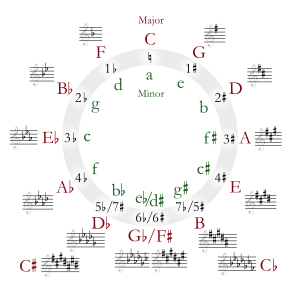D major facts for kids
 |
||
| Relative key | B minor | |
|---|---|---|
| Parallel key | D minor | |
| Notes in this scale | ||
| D, E, F♯, G, A, B, C♯, D | ||
- Also see: D minor.
D major is a major scale that starts on the note D. Think of it as a musical "flavor" that often sounds bright and cheerful. Its key signature has two sharps: F sharp (F♯) and C sharp (C♯). This tells musicians which notes to play a little higher when they are in this key. The relative minor of D major is B minor.
Contents
Why D Major is Special
D major is a very popular key for many reasons. It works well for different instruments and has a rich history in music.
For String Instruments
D major is excellent for violin music. This is because the violin's four strings are tuned to G, D, A, and E. The open D string can resonate (vibrate along) with other D notes. This creates a full, rich sound.
Many famous classical composers wrote violin concertos in D major. A violin concerto is a piece where a solo violin plays with an orchestra.
- Mozart wrote his Violin Concerto No. 2 (1775) and No. 4 (1775) in D major.
- Beethoven composed his Violin Concerto in 1806 in this key.
- Paganini's Violin Concerto No. 1 (1817) is also in D major.
- Other composers like Johannes Brahms (1878), Pyotr Ilyich Tchaikovsky (1878), Sergei Prokofiev (1917), Igor Stravinsky (1931), and Erich Wolfgang Korngold (1945) also chose D major for their violin concertos.
D major is also good for guitar music. If you use a special tuning called "drop tuning" for the lowest string, you can have two D notes as open strings. This makes the guitar sound very full.
For Wind Instruments
For some new wind instrument students, D major can be a bit tricky. This is because if you play a B-flat instrument, like a B-flat clarinet, music in D major transposes (changes) to E major. E major has four sharps, which can be harder for beginners to play.
However, the B-flat clarinet is still often used for music in D major. It's one of the keys with the most sharps that the B-flat clarinet can play well. Sometimes, if a piece starts in D minor with B-flat clarinets and then changes to D major, composers might switch to clarinets in A.
Most tin whistles are made in the key of D. This is because they are often played with fiddles, which also work well in D major.
In Baroque Music
In the Baroque period (roughly 1600-1750), D major was known as "the key of glory." Because of this, many pieces for the trumpet were written in D major. The bright sound of the trumpet fit perfectly with the grand feeling of D major.
Examples of trumpet pieces in D major include:
- Concertos by Fasch, Gross, Molter (No. 2), Leopold Mozart, Telemann (No. 2), and Giuseppe Torelli.
- Sonatas by Corelli, Franceschini, Purcell, and Torelli.
- Famous parts of Handel's Messiah, like "The Trumpet Shall Sound" and the "Hallelujah" chorus, are in D major.
After the valve trumpet was invented, composers could write for the trumpet in more keys. For example, Joseph Haydn wrote his famous trumpet concerto in E-flat major.
In Symphonies and Overtures
D major was a very popular key for symphonies and overtures.
- Joseph Haydn wrote 23 of his 104 symphonies in D major. This makes it the key he used most often for his symphonies.
- Many of Mozart's early symphonies are also in D major.
- The symphony actually grew from the overture. In the late 1700s, D major was by far the most common key for overtures.
Color and Sound
Some people experience music in a unique way, where they see colors when they hear sounds. This is called synesthesia. The composer Alexander Scriabin saw D major as golden in color. He once told another composer, Nikolai Rimsky-Korsakov, about an opera where a character sang in D major about gold.
| Diatonic Scales and Keys | |||||||||||||||||||||||||||||||||||||||||||||||||||||||
|---|---|---|---|---|---|---|---|---|---|---|---|---|---|---|---|---|---|---|---|---|---|---|---|---|---|---|---|---|---|---|---|---|---|---|---|---|---|---|---|---|---|---|---|---|---|---|---|---|---|---|---|---|---|---|---|
|
|||||||||||||||||||||||||||||||||||||||||||||||||||||||
| The table shows the number of sharps or flats in each scale. Minor scales are written in lower case. | |||||||||||||||||||||||||||||||||||||||||||||||||||||||
See also
 In Spanish: Re mayor para niños
In Spanish: Re mayor para niños


